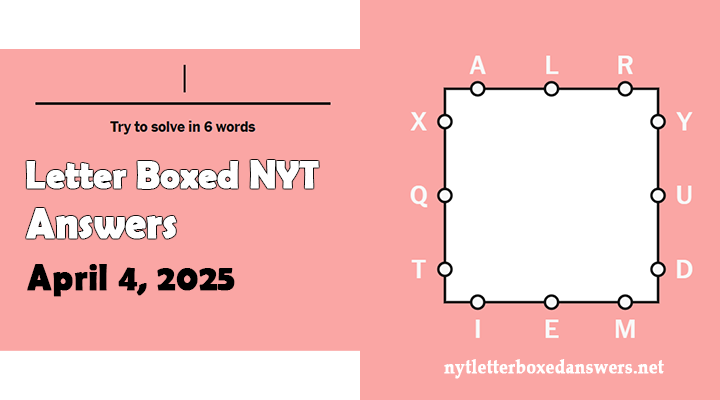NYT Letter Boxed quiz for Friday April 4, 2025 is released. We came up with Letter Boxed April 4 2025 Answers and Hints for you. With the help of these hints, you will be able to guess the words of letter boxed quiz without revealing the answers and get the solution.
| Top | Right | Bottom | Left |
|---|---|---|---|
| ALR | YUD | IEM | XQT |
| Two Words Solution | |
|---|---|
| QUILT | TAXIDERMY |
| MYRTLE | EQUIAXED |
| Three Words Solution | ||
|---|---|---|
| ADEQUATE | EXIT | TERMLY |

Word 01:
This word has 5 letters, starts with Q, and ends with T.
It’s a layered blanket made from pieces of fabric.
Often handmade and used for warmth or decoration.
Common in cozy or country-style bedrooms.
Can be passed down as a family heirloom.
Frequently features patchwork patterns.
Related to sewing and stitching hobbies.
Popular in American folk art.
Found in bedding sections of stores.
The opposite might be “sheet” or “comforter” (depending on style).
Word 02:
This word has 9 letters, starts with T, and ends with Y.
It refers to preserving and mounting dead animals.
Common in museums and hunting lodges.
Involves stuffing and posing animals realistically.
Often used for educational or display purposes.
Skilled work that requires anatomical knowledge.
Sometimes controversial due to ethical concerns.
Can be applied to fish, birds, mammals, etc.
Derived from Greek meaning “arrangement of skin.”
The opposite might be “decomposition” or “burial.”
Word 01:
This word has 6 letters, starts with M, and ends with E.
It’s a plant known for its fragrant white or pink flowers.
Often symbolizes love and immortality in mythology.
Found in warm and temperate climates.
Sometimes used in bridal wreaths or herbal remedies.
Its name can also refer to a female given name.
Part of the evergreen family.
Can grow as a shrub or small tree.
Mentioned in literature and ancient texts.
The opposite might be “thorn” or “weed.”
Word 02:
This word has 8 letters, starts with E, and ends with D.
Used in metallurgy and materials science.
Refers to grains that are equal in all dimensions.
Indicates uniformity in crystal structure.
Often desired in casting and welding.
Found in engineering and manufacturing texts.
Derived from “equal” and “axis.”
Helps improve material strength and performance.
Opposite of elongated or columnar grains.
Associated with microstructure analysis.
Word 01:
This word has 8 letters, starts with A, and ends with E.
It means “sufficient” or “good enough.”
Often used to describe a satisfactory amount.
Common in performance reviews or reports.
Synonym of “acceptable” or “reasonable.”
Opposite of “insufficient” or “lacking.”
Not overly impressive, but meets the need.
Can refer to skills, resources, or results.
Frequently seen in formal assessments.
Comes from Latin meaning “to make equal to.”
Word 02:
This word has 4 letters, starts with E, and ends with T.
It’s a way out or departure point.
Found in buildings, theaters, or roadways.
Opposite of “entrance.”
Common in emergency signage.
Can also mean leaving a situation or group.
Used in scripts to indicate a character leaving.
In tech, it’s used to close programs.
Symbol of escape or closure.
The word can be both a noun and a verb.
Word 03:
This word has 6 letters, starts with T, and ends with Y.
It means occurring once every academic term.
Common in school or university settings.
Describes things like exams, payments, or reports.
Often contrasted with “weekly” or “annually.”
Found in academic calendars.
Can relate to grades, schedules, or reviews.
Not widely used outside of educational contexts.
A British English term more than American.
Opposite would be “nonrecurring” or “irregular.”

Chris Brown is a passionate word game love and problem solving expert. With over 15 years of experience in solving puzzle challenges, he provides daily NYT Letter Boxed answers, tips and strategies to help other players so that they can improve their solving skills. Whether you are stuck on a tricky puzzle or looking for new techniques, Chris is here to guide you with his expert solutions.